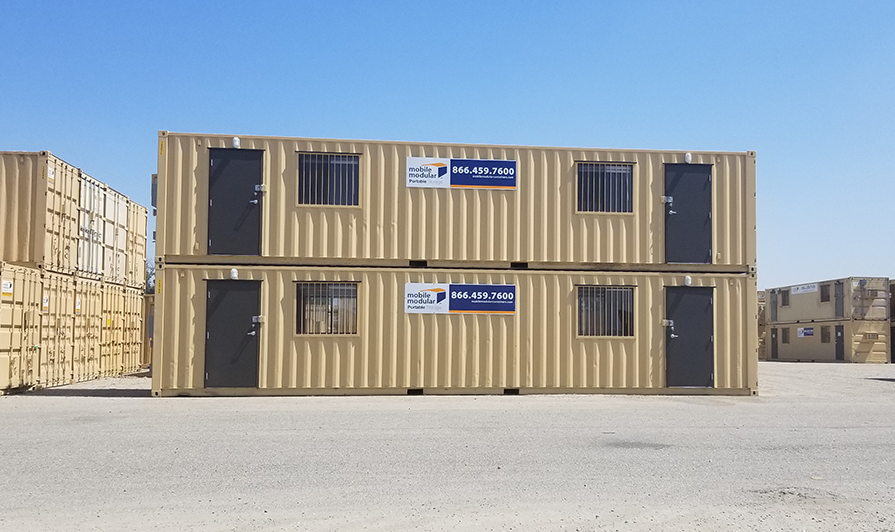- Rent, Lease, or Purchase
- |
February 19, 2021
Reasons Behind Rising Container Shipping Rates During COVID-19

Booming consumer demands, equipment shortages, social distancing, safety measures, scarcity of labor, and pre and post-lockdown stocking have all contributed to the current disruption of global trade and supply chain patterns. This has caused intense pressure and strain on the global container shipping industry.
Significantly affecting trade and logistics, the spread of the coronavirus slowed down trade processes through increased checks and restrictions, causing major congestion at various major ports around the world. Such disruptions rippling through international waters have benchmarked higher container costs and ocean freight rates for much of 2020.
An Incredible Surge in Shipping Container Prices and Freight Rates
- In 2020, prices rose above $5,000/FEU (Forty-foot Equivalent Unit) on Asia-East Coast lanes, with West Coast rates passing $4000/FEU. These rates are three times higher than rates this time last year.
- According to sources, the cost of containers coming out of Asia has seen hikes and volatility, with prices ranging between $3,600 to $4,100 per container.
- The freight index cost by Shanghai Shipping Exchange rose to 2048.27, twice that of April's 855.34 figure.
- The shortage has hit importers. The share of import numbers to ports like Los Angeles and Long Beach fell 13% in the first quarter of 2020 alone.
- The China to US West Coast rate FREIGHTOS-CN-USWC rose by nearly 50% since July 1, to rates of $3,878 per container in November. (prices are subject to changes)(they are different now)
- Freight shipping costs between France and the UK quadrupled in the final week of 2020. The spot rate for last-minute shipments across the English Channel reached 6-10 euros per kilometer ($4.56 a mile) for a full truckload.
Why did Ocean Freight Rates Rise during COVID-19?
Additional Costs
In 2019, the freight rates were stubbornly low, along with slow global trade and rising fuel costs. At the beginning of 2020, the International Maritime Organization implemented environmental regulations, banning ships operating on fuel with more than 0.5% sulfur content. The environmental surcharges and costs of converting vessels to alternative fuels and other shipping costs increased ocean freight rates for shippers.
Furthermore, with the onset of the coronavirus, carriers started implementing equipment imbalance and peak season surcharges along with the general freight rate to recover their costs.
Trade Imbalance
As a global manufacturer and a major consumer of agricultural and other global products, China was the first to feel the hit of the widespread pandemic. Disruptions in manufacturing resulted in significant cargo backlogs in China’s container ports, while ocean carriers announced blanked sailings in the effort to curb the coronavirus. Travel restrictions during lockdowns also led to a shortage of drivers to transport containers.
These setbacks impacted industries across the world, including automotive, electronics, and consumer goods. However, China recovered its export volume quickly (a 21% surge compared to the previous year, in November) by supplying high demand products such as medical and personal protective equipment, appliances, clothes, home products, etc.
However the spread of COVID-19 overseas and rising risk has restricted the movement of goods, causing delays in containers returning to China with imported goods from other countries. The shipping industry started witnessing lopsided trading. For every three containers exported, China is importing one.
The average navigation time for containers in China has increased to 100 days from 60, and the global average has risen from 45 to 61 days.
The long wait to unload cargo while incurring storage costs on limited revenue caused a shift in the demand curve for containers, leading to increased container and freight costs.
According to Drewry’s Container Equipment Forecaster, a 20-foot dry box cost $2,100 in early July. The price reached $2,500 by the end of September and was nearly $2,650 per 20-foot standard dry freight container in October 2020.
Demand Shift from Air to Sea
The suspension of international passenger flights that often carry cargo has boosted the demand for ocean freight space. However, with few changes in the current scenario, further pressure on ocean trade and freight space has resulted in a shortage of containers and increased shipping rates.
Container Mafias
Due to the increase in demand for containers, some private Chinese firms started hoarding containers to offer them to the highest bidder in an attempt to earn quick profits. This requires manufacturers and exporters to pay extra to gain access to a container from a private yard, while the wait to acquire a container takes two to four weeks.
Others want to avoid delays and are willing to pay double the price, but carriers will not guarantee a spot or space to transport their cargo.
Unprecedented Blank Sailings
Carriers often cancel or blank voyages to earn short-term profits. That means containers go to areas where there's more earning and profitability, instead of where the need is high. The problem of increased freight costs became acute due to several blanked (canceled) sails in the first part of the year.
Then a sudden rise in demand after months of blanked sailing reduced container availability. According to Globalia, container availability for 40 ft. HCs across China are currently at just 0.05 CAx points; this number was 0.63 at the same time last year.
Trade Wars
Politics affected the economy and played its part in shipping prices going out of control, adding to the woes of shippers and many freight forwarders.
Trade wars, between Europe and the US, between China and Australia, China and the US have adversely affected rates, shipping lines, and logistics processes.
Impact of the COVID-19 Crisis on Air Freight
Along with the shipping industry, the airline market also received bad news, seeing a decline in passenger traffic of over 90%. With grounded airlines, airfreight lost 50% of its cargo capacity. However, the increase in demand for goods, especially personal protective equipment, led to increased airfreight rates.
The rates from Asia to the US increased up to $20 per kilogram, about five times more than the standard $3-4 per kilogram range. Airfreight rates between Hong Kong and North America were roughly 5.66 U.S. dollars per kilogram in October 2020.
Some freight forwarders even hired chartered planes to transport cargo, paying a hefty price of almost $1 million during this timeframe .
As the coronavirus pandemic lingers on and vaccine drives are only beginning, economic uncertainty in the market remains prevalent.
According to Lars Jensen, chief executive at Sea Intelligence Consulting, if the pandemic is brought under control and consumers start spending more on services such as travel and less on goods, the container demand could drop.
Certainly, ramping up new build manufacturing capacity will bring some relief to delays and the supply crisis. Still, the best changes will come only as cargo demands and carrier schedules normalize, and the current disruption to economies unwinds by mid-2021.
Note: Even though shipping container rates are at an all-time high globally, businesses in the United States can acquire containers for portable offices and commercial storage at competitive prices. You can count on Mobile Modular Portable Storage for container rental and purchase plans that fit your budget even in difficult times.
To rent or buy shipping containers, get in touch with us today.
Related Blogs



Subscribe to Our Blog
Enter your email address to subscribe to the blog and receive the notification of new posts by email.
Thank You for Subscribing to Our Blog!
Stay tuned for upcoming emails with valuable content that we hope will enhance your experience with our brand.
Both Pardot and mg360 form submissions failed.
